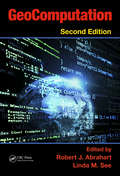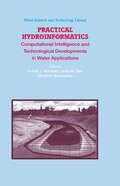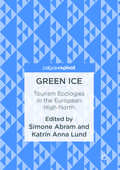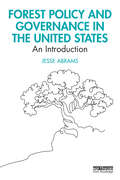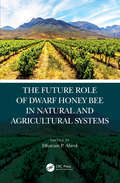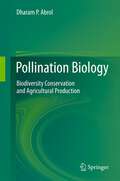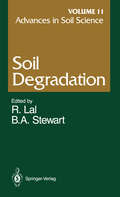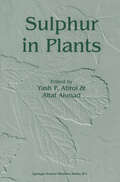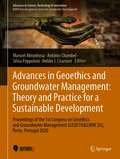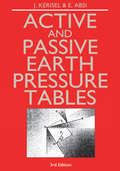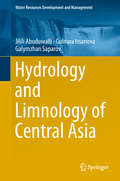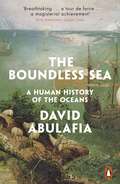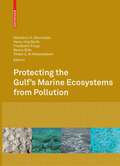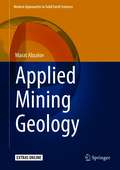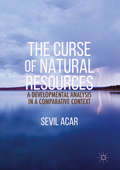- Table View
- List View
GeoComputation
by Robert J. Abrahart Linda M. SeeA revision of Openshaw and Abrahart's seminal work, GeoComputation, Second Edition retains influences of its originators while also providing updated, state-of-the-art information on changes in the computational environment. In keeping with the field's development, this new edition takes a broader view and provides comprehensive coverage across the
Practical Hydroinformatics: Computational Intelligence and Technological Developments in Water Applications (Water Science and Technology Library #68)
by Robert J. Abrahart Linda M. See Dimitri P. SolomatineHydroinformatics is an emerging subject that is expected to gather speed, momentum and critical mass throughout the forthcoming decades of the 21st century. This book provides a broad account of numerous advances in that field - a rapidly developing discipline covering the application of information and communication technologies, modelling and computational intelligence in aquatic environments. A systematic survey, classified according to the methods used (neural networks, fuzzy logic and evolutionary optimization, in particular) is offered, together with illustrated practical applications for solving various water-related issues. ...
Green Ice: Tourism Ecologies in the European High North
by Simone Abram Katrín Anna LundThis book presents lively case studies of tourism developments in the European High North from diverse perspectives. It compares views of the changing political ecology of a fragile region shaped by climatic and cultural factors. In exploring the mutual relations between new developments in Arctic travel narratives and tourism practices. Green Ice: Tourism Ecologies in the European High North pays particular attention to the changing discourses that produce, and are in turn produced by, encounters between contemporary Arctic peoples and territories. Questions of gender and nationality are considered alongside a comparison of texts and practices in different languages, examining the politics of language and its significant role in tourism. This title pays attention to the changing symbolic value of Arctic discourses in environmental movements, in order to consider the close connections between global forms of environmentalist discourse and action and local cultural responses. An engaging and timely work, this book will be of great interest to scholars of Geography, Anthropology, and Arctic Tourism.
Forest Policy and Governance in the United States: An Introduction
by Jesse AbramsThis new textbook provides an up-to-date and comprehensive introduction to both the policy background and contemporary governance of forests in the United States. Starting with a history of the development of forest policies and conservation agencies, the book then explores the diversity of forest owners, users, and uses and examines emerging approaches to forest governance that cross traditional jurisdictional and property boundaries. It tackles key contemporary issues such as the forest water nexus, the conservation of threatened and endangered species, and the challenges of managing fire, insect, and disease dynamics under a changing climate. Key focal areas include the emergence of collaborative approaches to forest governance, community forest relationships, changes to corporate timberland ownership, and contemporary governance mechanisms such as certification and payments for ecosystem services. This text raises the "big questions" about the distribution of rights and responsibilities in forest management, the tensions between equity and efficiency, and how to sustain a diversity of forest values under the pressures of ecological and social complexity. Written in an accessible and engaging manner, this textbook provides a timely synthesis of both the foundations and current trends and issues in forest policy and governance in the United States with a strong emphasis on illustrative real-world cases. Forest Policy and Governance in the United States is essential reading for students in forest and natural resource policy courses and will be of great use to students in environmental governance courses. It will also be of interest to policymakers and professionals working in forest conservation and in the forest industry.
Forest Policy and Governance in the United States: An Introduction
by Jesse AbramsThis new textbook provides an up-to-date and comprehensive introduction to both the policy background and contemporary governance of forests in the United States. Starting with a history of the development of forest policies and conservation agencies, the book then explores the diversity of forest owners, users, and uses and examines emerging approaches to forest governance that cross traditional jurisdictional and property boundaries. It tackles key contemporary issues such as the forest water nexus, the conservation of threatened and endangered species, and the challenges of managing fire, insect, and disease dynamics under a changing climate. Key focal areas include the emergence of collaborative approaches to forest governance, community forest relationships, changes to corporate timberland ownership, and contemporary governance mechanisms such as certification and payments for ecosystem services. This text raises the "big questions" about the distribution of rights and responsibilities in forest management, the tensions between equity and efficiency, and how to sustain a diversity of forest values under the pressures of ecological and social complexity. Written in an accessible and engaging manner, this textbook provides a timely synthesis of both the foundations and current trends and issues in forest policy and governance in the United States with a strong emphasis on illustrative real-world cases. Forest Policy and Governance in the United States is essential reading for students in forest and natural resource policy courses and will be of great use to students in environmental governance courses. It will also be of interest to policymakers and professionals working in forest conservation and in the forest industry.
Multiphase Migration of Organic Compounds in a Porous Medium: A Mathematical Model (Lecture Notes in Engineering #8)
by Linda M. AbriolaGroundwater has long been one of the world's most important resources. It accounts for approximately 96% of all fresh water in the United States and supplies more than 50% of the population with potable water. Historically, this water source has generally been regarded as pristine. However, in recent years, contamination of ground water by industrial products has become a problem of growing concern. During the past four decades, the variety and quantity of organic chemicals produced in the U. S. has steadily increased. Currently, more than 40,000 different organic compounds are being manufactured, trans ported, used and eventually disposed of in the environment (Wilson, et !l (1981». Production and consumption of petroleum products has also risen in this same time period. Many of these industrial compounds are highly toxic and slightly water soluble. Thus, they pose a poten tial threat to large volumes of groundwater if they are somehow intro duced into the subsurface. Increased production of chemicals implies the increased risk of accidental spills or leakage to the soil, and indeed, the literature abounds with contamination case histories. 2 Incidences of petroleum contamination of groundwater have been documented by many authors. For example, see: Schwi11e (1967); Toms (1971); Guenther (1972); McKee, et!l (1912); Williams and Wilder (1971); Van100cke, et ~]-
The Future Role of Dwarf Honey Bees in Natural and Agricultural Systems
by D. P. AbrolThe future role of dwarf honeybees in natural and agricultural systems provides multidisciplinary perspective about the different facets of dwarf honeybees. The role of dwarf honeybee Apis florea assumes utmost importance in the context of pollinator decline throughout the world threatening stability of ecosystems and global food security. Apis florea is a low land species of south Asia extending more to the west than other Asiatic Apis species. It is an important pollinator of crops in hot and dry agricultural plains. The book is first of its kind which deals in details on varied aspects of Apis florea biology, management, conservation strategies for protecting biodiversity and enhancing crop productivity. The book aims to promote a large, diverse, sustainable, and dependable bee pollinator workforce that can meet the challenge for optimizing food production well into the 21st century. Features: Apis florea provides source of livelihood in mountainous areas and marginal farmers. This book will for the first time present the beekeeping from the perspective of agricultural production and biodiversity conservation An excellent source of advanced study material for academics, researchers and students and programme planners Excellent pollinator of tropical and subtropical crops fruits vegetables etc less prone to diseases and enemies Covering the latest information on various aspects of Apis florea biology, this book brings the latest advances together in a single volume for researchers and advanced level students This book will be useful to pollination biologists, honeybee biologists in entomology departments, students, teachers, scientists of agriculture, animal behaviour, botany, conservation, biology, ecology, entomology, environmental biology, forestry, genetics, plant breeding, horticulture, toxicology, zoology, seed growers and seed agencies and shall serve as reference book for students, teachers, researchers, extension functionaries and policy planners.
The Future Role of Dwarf Honey Bees in Natural and Agricultural Systems
by Dharam P. AbrolThe future role of dwarf honeybees in natural and agricultural systems provides multidisciplinary perspective about the different facets of dwarf honeybees. The role of dwarf honeybee Apis florea assumes utmost importance in the context of pollinator decline throughout the world threatening stability of ecosystems and global food security. Apis florea is a low land species of south Asia extending more to the west than other Asiatic Apis species. It is an important pollinator of crops in hot and dry agricultural plains. The book is first of its kind which deals in details on varied aspects of Apis florea biology, management, conservation strategies for protecting biodiversity and enhancing crop productivity. The book aims to promote a large, diverse, sustainable, and dependable bee pollinator workforce that can meet the challenge for optimizing food production well into the 21st century. Features: Apis florea provides source of livelihood in mountainous areas and marginal farmers. This book will for the first time present the beekeeping from the perspective of agricultural production and biodiversity conservation An excellent source of advanced study material for academics, researchers and students and programme planners Excellent pollinator of tropical and subtropical crops fruits vegetables etc less prone to diseases and enemies Covering the latest information on various aspects of Apis florea biology, this book brings the latest advances together in a single volume for researchers and advanced level students This book will be useful to pollination biologists, honeybee biologists in entomology departments, students, teachers, scientists of agriculture, animal behaviour, botany, conservation, biology, ecology, entomology, environmental biology, forestry, genetics, plant breeding, horticulture, toxicology, zoology, seed growers and seed agencies and shall serve as reference book for students, teachers, researchers, extension functionaries and policy planners.
Pollination Biology: Biodiversity Conservation and Agricultural Production
by Dharam P. AbrolThis book has a wider approach not strictly focused on crop production compared to other books that are strictly oriented towards bees, but has a generalist approach to pollination biology. It also highlights relationships between introduced and wild pollinators and consequences of such introductions on communities of wild pollinating insects. The chapters on biochemical basis of plant-pollination interaction, pollination energetics, climate change and pollinators and pollinators as bioindicators of ecosystem functioning provide a base for future insights into pollination biology. The role of honeybees and wild bees on crop pollination, value of bee pollination, planned honeybee pollination, non-bee pollinators, safety of pollinators, pollination in cages, pollination for hybrid seed production, the problem of diseases, genetically modified plants and bees, the role of bees in improving food security and livelihoods, capacity building and awareness for pollinators are also discussed.
Advances in Soil Science: Soil Degradation Volume 11 (Advances in Soil Science #11)
by I. P. Abrol P. Alvo F. De Coninck H. Eswaran N. R. Fausey R. K. Gupta R. Lal T. J. Logan D. A. MacLeod E. McKyes C. E. Mullins K. H. Northcote G.S.V. Raghavan G. K. Sims B. A. Stewart J. M. Tisdall T. Varghese I. M. YoungThe purpose of Advances in Soil Science is to provide a forum for leading scientists to analyze and summarize the available scientific information on a subject, assessing its importance and identifying additional research needs. A wide array of subjects has been addressed by authors from many countries in the initial ten volumes of the series. The quick acceptance of the series by both authors and readers has been very gratifying and confirms our perception that a need did exist for a medium to fill the gap between the scientific journals and the comprehensive reference books. This volume is the first of the series devoted entirely to a single topic soil degradation. Future volumes will include both single-topic volumes as well as volumes containing reviews of different topics of soil science, as in the case of the first ten volumes. There are increasing concern and attention about managing natural re sources, particularly soil and water. Soil degradation is clearly one of the most pressing problems facing mankind. Although the spotlight regarding soil degradation in recent years has focused on Africa, concern about the degradation of soil and water resources is worldwide. The widespread con cern about global environmental change is also being linked to severe problems of soil degradation. Therefore, we are indeed pleased that the first volume of the series devoted to a single topic addresses such an impor tant issue. The current volume is also the first of the series involving a guest editor.
Sulphur in Plants
by Yash P. AbrolSulphur (S) plays a pivotal role in various plant growth and development processes being a constituent of sulphur-containing amino acids, cysteine and methionine, and other metabolites viz., glutathione and phytochelatins, co-factor of enzymes which contribute to stress repair and amelioration of heavy metal toxicity. Besides, a number of S-containing components are biologically active and, thus, a source for use as medicinal value. The basic global issue before the agricultural scientist and world community is to evolve cultivars and develop methodologies for efficient use of inputs to enhance agricultural productivity. This is particularly true of the developing countries which are going to see maximum rise in population with changing food demands and declining availability of land. Amongst the inputs, nutrients play a crucial role. The major requirement is for N, P and K followed by several micro-nutrients. In this context reports of world-wide S deficiency in the agricultural systems are relevant. The reasons are many. Broadly speaking reduction inS emission, use of S-free N, P and K fertilizers and higher biomass production contributed the maximum. Despite the need for sulphur as an essential plant nutrient and the substantial returns expected from its use, very little attention has been given to fill the gap between supply and demand of S.
Advances in Geoethics and Groundwater Management: Proceedings of the 1st Congress on Geoethics and Groundwater Management (GEOETH&GWM'20), Porto, Portugal 2020 (Advances in Science, Technology & Innovation)
by Manuel Abrunhosa António Chambel Silvia Peppoloni Helder I. ChaminéThis book gathers the peer-reviewed proceedings of the 1st congress on Geoethics & Groundwater Management (GEOETH&GWM'20), held in Porto, Portugal, in an online format on 18-22 May 2020. Hosted in School of Engineering (ISEP), Polytechnic of Porto based on Porto city (a UNESCO World Heritage Site), the international conference focused on what has now been dubbed “hydrogeoethics”, a novel transdisciplinary, scientific field integrating all dimensions of geoethics in groundwater science and practice. Given its scope, the book is of interest to all researchers and practitioners in the geosciences, hydrology, water resources, hydrogeology, natural resources management, environment, engineering, law, sociology, education, philosophy, culture, among others.This joint congress is the result of a collaborative agreement between the IAH (International Association of Hydrogeologists) and IAPG (International Association for Promoting Geoethics) and reflects the need for concerted actions to achieve sustainable development.The diversity, scale, significance and increasing magnitude of anthropogenic interactions with aquifers and groundwater, which often involve conflicting values or interests, call for analysis, discussions and decisions on the part of the agents involved, e.g. groundwater scientists, policymakers, managers, organisations, professionals and citizens. This approach calls for a responsible, sustainable and human approach to groundwater use and management.The groundwater community involved in the exploration and exploitation, use and management of this increasingly vital natural resource is becoming more and more aware that ethical issues pervade all our attitudes from concept to action and need to be addressed. Diverse values and cultures, science and education, law and policies, human and natural environments and the public and the economic sectors view groundwater and its value and/or role differently. The authors believe that in a globalised and interconnected world, common ground must be found in the interest of peace, human development and sustainability. The main topics covered here include:1. Fundamentals of hydrogeoethics: cultures, principles and geoethical values on groundwater science and engineering2. Lessons for a resilient and sustainable future with hydrogeoethics: case studies of geoethics in groundwater science-engineering, profession, and management3. Scientific and humanistic components of hydrogeoethics in groundwater education and professional training 4. Socio-hydrogeology and ethical groundwater management 5. Geoethics of decision making under uncertainty and ethical issues in neglecting groundwater functioning 6. Groundwater: geological, legal, social, and ethical challenges of a unique natural resource
Active and Passive Earth Pressure Tables
by E. AbsiThe problem of earth pressure on retaining structures is one of the oldest in soil mechanics. This volume comprises tables which facilitate calculations in problems of limit equilibrium. These tables provide coefficients which are extreme values in which the soil still is in equilibrium. They are or
Active and Passive Earth Pressure Tables
by E. AbsiThe problem of earth pressure on retaining structures is one of the oldest in soil mechanics. This volume comprises tables which facilitate calculations in problems of limit equilibrium. These tables provide coefficients which are extreme values in which the soil still is in equilibrium. They are or
Soil Carbon: Science, Management and Policy for Multiple Benefits
by Dave Abson Christiano Ballabio Francesca Bampa Andre Bationo Niels Batjes Martial Bernoux Tapas Bhattacharyya Daniel Buschiazzo Carlos Eduardo Cerri Rich Conant Heitor L.C. Coutinho Chris Duffy Christian Feller Roger Funk Patrick Gicheru Marty Goldhaber Hans Joosten Pierre-Alain Maron Luca Montanarella Generose Nziguheba Genxing Pan Unai Pascual David Powlson Pete Smith Meine Van Noordwijk Bas Van Wesemael David Werner Yongcun ZhaoThis book brings together the essential evidence and policy opportunities regarding the global importance of soil carbon for sustaining Earth's life support system for humanity. Covering the science and policy background for this important natural resource, it describes land management options that improve soil carbon status and therefore increase the benefits that humans derive from the environment. Written by renowned global experts, it is the principal output from a SCOPE rapid assessment process project.
The Grand Ethiopian Renaissance Dam on the Blue Nile (Springer Geography)
by Wossenu Abtew Shimelis Behailu DessuThis book is about the Grand Ethiopian Renaissance Dam newly being built on the Blue Nile, a transboundary river. Due to rising population and increasing water demand in the Nile basin, major projects raise interest and concern by millions with potential for water conflict. The dam design, reservoir filling policy, operation of the dam, riparian countries response, dam site importance and social impact and economy of the dam are presented in the book.
Evaporation and Evapotranspiration: Measurements and Estimations
by Wossenu Abtew Assefa MelesseThe book is a thorough presentation of theoretical and applied aspects of the evaporation and evapotranspiration process supported by data from experimental studies. It is written in a way that the theoretical background of evaporation and evapotranspiration estimation is presented in a simplified manner, comprehensive to most technical readers. The book deals with details of meteorological parameters and monitoring sensors which are needed for estimating evaporation and evapotranspiration. Errors in meteorological parameter measurements are also presented. Estimation errors, strengths, weaknesses and applicability of a wide range of evaporation and evapotranspiration estimation methods are presented along with samples of application to a certain region. Application of newer simpler methods is presented. A new technology, remote sensing application to evaporation and evapotranspiration estimation, is presented. The latest interest in the subject, climate change and evapotranspiration is presented in the last chapter. This book will be beneficial to students, hydrologists, engineers, meteorologists, water managers and others.
Hydrology and Limnology of Central Asia (Water Resources Development and Management)
by Jilili Abuduwaili Gulnura Issanova Galymzhan SaparovThis book highlights the development of lake systems and water reservoirs as well as the impact of climate change on water resources in Central Asian countries. It provides information on the genesis of lake basins, physical and chemical properties of water in lakes, and the hydrological regimes (water balance and fluctuation levels) of lakes of Central Asia and Xinjiang. The book is useful for scientists and researchers whose work focuses on lakes and the use of natural resources, irrigation, hydropower and water supply, as well as for students and planners.
Advances in Analysis and Design of Deep Foundations: Proceedings of the 1st GeoMEast International Congress and Exhibition, Egypt 2017 on Sustainable Civil Infrastructures (Sustainable Civil Infrastructures)
by Murad Abu-Farsakh Khalid Alshibli Anand PuppalaThis volume on “Advances in Analysis and Design of Deep Foundations” contains 22 technical papers which cover various aspects of analysis and design of deep foundations based on full-scale field testing, numerical modeling, and analytical solutions. The technical papers are 8-10 pages long that present the results and findings from research as well as practical-oriented studies on deep foundations that are of interest to civil/geotechnical engineering community. The topics cover a wide spectrum of applications that include evaluation of the axial and lateral capacity of piles, pile group effects, evaluation of the increase in pile capacity with time (or pile setup), influence of excavation on pile capacity, study the behavior of pile raft caisson foundations, evaluate the bearing capacity and settlement of piles from cone penetration tests, etc. This volume is part of the proceedings of the 1st GeoMEast International Congress and Exhibition on Sustainable Civil Infrastructures, Egypt 2017.
The Boundless Sea: A Human History of the Oceans
by David AbulafiaFrom the award-winning author of The Great Sea, a magnificent new global history of the oceans and of humankind's relationship with the sea For most of human history, the seas and oceans have been the main means of long-distance trade and communication between peoples - for the spread of ideas and religion as well as commerce. This book traces the history of human movement and interaction around and across the world's greatest bodies of water, charting our relationship with the oceans from the time of the first voyagers. David Abulafia begins with the earliest of seafaring societies - the Polynesians of the Pacific, the possessors of intuitive navigational skills long before the invention of the compass, who by the first century were trading between their far-flung islands. By the seventh century, trading routes stretched from the coasts of Arabia and Africa to southern China and Japan, bringing together the Indian Ocean and the western Pacific and linking half the world through the international spice trade. In the Atlantic, centuries before the little kingdom of Portugal carved out its powerful, seaborne empire, many peoples sought new lands across the sea - the Bretons, the Frisians and, most notably, the Vikings, now known to be the first Europeans to reach North America. As Portuguese supremacy dwindled in the late sixteenth century, the Spanish, the Dutch and then the British each successively ruled the waves.Following merchants, explorers, pirates, cartographers and travellers in their quests for spices, gold, ivory, slaves, lands for settlement and knowledge of what lay beyond, Abulafia has created an extraordinary narrative of humanity and the oceans. From the earliest forays of peoples in hand-hewn canoes through uncharted waters to the routes now taken daily by supertankers in their thousands, The Boundless Sea shows how maritime networks came to form a continuum of interaction and interconnection across the globe: 90 per cent of global trade is still conducted by sea. This is history of the grandest scale and scope, and from a bracingly different perspective - not, as in most global histories, from the land, but from the boundless seas.
Protecting the Gulf's Marine Ecosystems from Pollution
by Abdulaziz H. Abuzinada Hans-Jörg Barth Friedhelm Krupp Benno Böer Thabit Zahran Al AbdessalaamThis volume reviews present sources and levels of pollution in The Gulf, assesses their causes and effects on biota and ecosystems, and identifies preventive and remedial measures reducing levels of pollution and mitigating adverse impacts. It is supported by UNESCO, Doha.
Applied Mining Geology (Modern Approaches in Solid Earth Sciences #12)
by Marat AbzalovThis book provides a detailed overview of the operational principles of modern mining geology, which are presented as a good mix of theory and practice, allowing use by a broad range of specialists, from students to lecturers and experienced geologists.The book includes comprehensive descriptions of mining geology techniques, including conventional methods and new approaches. The attributes presented in the book can be used as a reference and as a guide by mining industry specialists developing mining projects and for optimizing mining geology procedures. Applications of the methods are explained using case studies and are facilitated by the computer scripts added to the book as Electronic Supplementary Material.
Image Processing and Data Analysis with ERDAS IMAGINE®
by Stacy A.C. Nelson Siamak KhorramRemotely sensed data, in the form of digital images captured from spaceborne and airborne platforms, provide a rich analytical and observational source of information about the current status, as well as changes occurring in, on, and around the Earth’s surface. The data products, or simply images processed from these platforms, provide an additional advantage in that geographic areas or regions of interest can be revisited on a regular cycle. This revisit cycle allows geospatial analysts and natural resource managers to explore changing conditions over time. Image Processing and Data Analysis with ERDAS IMAGINE® explains the principles behind the processing of remotely sensed data in a simple, easy to understand, and "how-to" format. Organized as a step-by-step guide with exercises adapted from original research and using publicly available imagery, such as NASA Landsat, ESA Sentinel-2, Orthophotos, and others, this book gives readers the ability to quickly gain the practical experience needed to navigate the ERDAS IMAGINE® software as well as learn certain applications in Esri’s ArcMap ArcGIS for Desktop software and Quantum the GIS (QGIS) open source applications package. It also helps readers to easily move beyond the information presented in this book and tackle more advanced skills. Written by two professors with long experience in remote sensing and image processing, this book is a useful guide and reference for both undergraduate and graduate students, researchers, instructors, managers, and agency professionals who are involved in the study of Earth systems and the environment.
Image Processing and Data Analysis with ERDAS IMAGINE®
by Stacy A.C. Nelson Siamak KhorramRemotely sensed data, in the form of digital images captured from spaceborne and airborne platforms, provide a rich analytical and observational source of information about the current status, as well as changes occurring in, on, and around the Earth’s surface. The data products, or simply images processed from these platforms, provide an additional advantage in that geographic areas or regions of interest can be revisited on a regular cycle. This revisit cycle allows geospatial analysts and natural resource managers to explore changing conditions over time. Image Processing and Data Analysis with ERDAS IMAGINE® explains the principles behind the processing of remotely sensed data in a simple, easy to understand, and "how-to" format. Organized as a step-by-step guide with exercises adapted from original research and using publicly available imagery, such as NASA Landsat, ESA Sentinel-2, Orthophotos, and others, this book gives readers the ability to quickly gain the practical experience needed to navigate the ERDAS IMAGINE® software as well as learn certain applications in Esri’s ArcMap ArcGIS for Desktop software and Quantum the GIS (QGIS) open source applications package. It also helps readers to easily move beyond the information presented in this book and tackle more advanced skills. Written by two professors with long experience in remote sensing and image processing, this book is a useful guide and reference for both undergraduate and graduate students, researchers, instructors, managers, and agency professionals who are involved in the study of Earth systems and the environment.
The Curse of Natural Resources: A Developmental Analysis in a Comparative Context
by Sevil AcarThis book examines the paradox that resource-rich countries often struggle to manage their resources in a way that will help their economies thrive. It looks at how a country's political regime and quality of governance can determine the degree to which it benefits - or suffers - from having natural resources, shifting away from the traditional focus on economic growth data to study the complex implications of these resources for human well-being and sustainable development. To this end, Acar examines a panel of countries in terms of the effects of their natural resources on human development and genuine saving, which is a sustainability indicator that takes into account the welfare of future generations by incorporating the changes in different kinds of capital. Acar finds that the exportation of agricultural raw materials is associated with significant deterioration in human development, while extractive resource exports, such as energy and minerals, have negative implications for genuine savings. Next, the book compares the development path of Norway before and after discovering oil, contrasting it with Sweden's development. The two countries, which followed almost identical paths until the 1970s, diverged significantly in terms of per capita income after Norway found oil.
